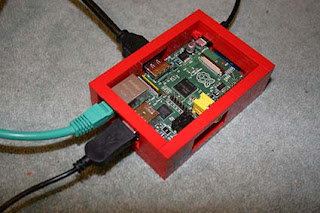The Raspberry Pi Foundation is a UK registered charity (Registration Number 1129409) See Website
The Raspberry Pi is for me an ideal computer. I started computing with a TRS-80 in 1980. When I bought that computer and switched it on my Mum, said what is this, ask it who was the Queen of England in 1654?
Now that machine would only do BASIC and only what I could program it to do. Before I could do anything I had to learn to program. Within a few weeks I was writing complex programs to do all sort of things. As a computing teacher I have had many students in my class who could use a computer , but whom had no idea about what you could get a computer to do.
I feel like many that this computer is a great step forward by taking a few steps back.
I sat in ignorance of this computer until this morning when Linux Format came through my postbox.
This seems the ideal computer for education. A small Linux platform and a simple programming language. Costing $35 dollars for 256Mb RAM, 2 USB port, an Ethernet port, an ARM1176JZFS, with floating point, running at 700Mhz, and a Videocore 4 GPU. The GPU is capable of BluRay quality playback, using H.264 at 40MBits/s..The Raspberry Pi measures 85.60mm x 53.98mm x 17mm, with a little overlap for the SD card and connectors which project over the edges. It weighs 45g.
The first shipments are with out a case which makes the computer look more like a machine that can be played with, than a black box. Later versions will have a case.
The computer has no keyboard ( so one needs to be supplied ( although it would probably fit inside one, no monitor ( any HDMI monitor TV will do) or disk. The OS is on a 16Mb or 32Mb full size SD card. The power is from 4AA cells or a small power supply a a mini 5V USB (phone style) connector.
There is already an enthusiastic following and video's up on You Tube to look at.
At the launch in a week or so's time there is another addon board, (the Gertboard) which will allow the user to use GPIO ( General Purpose Input and Output) and the ability to add any other hardware to the computer for a truly fantastic IO experience.
Because of its small size this computer will probably find its way into all sorts of other hardware, becoming the computer controller for many familiar devices.
Many years ago I was involved in creating a Beowulf cluster. With the Raspberry PI this might again became a great possibility. My students learnt an enormous amount from being able to build such a cluster. By having small inexpensive computers the way to opened up to users to discover how all types of computer systems work. Instead of having to buy several servers, the same systems could be created for well less than £100.
What can the added to the system.
Would be developers are talking about adding touch screens and other devices to the Raspberry. The appeal is a machine that is very basic - that will teach the basics of computer hardware and software. The appeal of this machine might just see it appearing in every device you can think of.
 When we ask the program to print out the answer - the value of age - then what ever you typed in is what ois displayed.
When we ask the program to print out the answer - the value of age - then what ever you typed in is what ois displayed.










 A new series of Python Programming is available on
A new series of Python Programming is available on 



